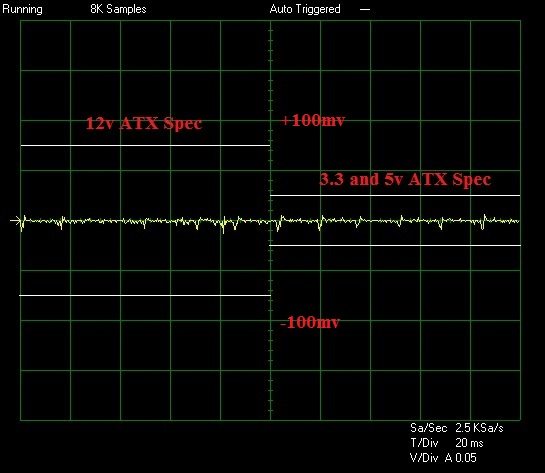BitFenix Fury 750G Semi-Modular Power Supply Review
Ryan Martin / 10 years ago
Ripple
Noise and Ripple can easily be measured by an oscilloscope. These show how much voltage fluctuation there is on a particular rail. We tested the rail stability of the 3.3 volt, 5 volt and 12 volt rails using an identical time and millivolt scale for all graphs. millivolt ripple is measured by the peak to peak size of the voltage curve.

Sample Ripple Graph
The latest ATX 12 volt version 2.3 specifications state that ripple from peak to peak must be no higher than 50 millivolts for the 3.3 volt and 5 volt rails, while the 12 volt rail is allowed up to 120 millivolts peak to peak to stay within specifications. Millivolt figures are stated to the closest increment of 5 given their variability.
| Load (%) | 3.3V Ripple | 5V Ripple | 12V Ripple |
| 20 | 17.6 | 10.6 | 24.6 |
| 40 | 20.4 | 15.4 | 31.9 |
| 60 | 24.5 | 20.2 | 39.8 |
| 80 | 25.2 | 22.8 | 48.8 |
| 100 | 28.6 | 25.2 | 58 |
Ripple suppression on the BitFenix Fury 750G was a bit mediocre. For such an enthusiast targeted unit nearly 30 mV on both the 3.3 and 5 volt rails as well as 60 mV on the 12 volt isn’t anything impressive. For a high end unit around 15mV for the 3.3 and 5 volt rail and 30-40 mV for the 12 volt rail is what I’d consider good.
3.3 volt @ 100%

5 volt @ 100%

12 volt @ 100%




















